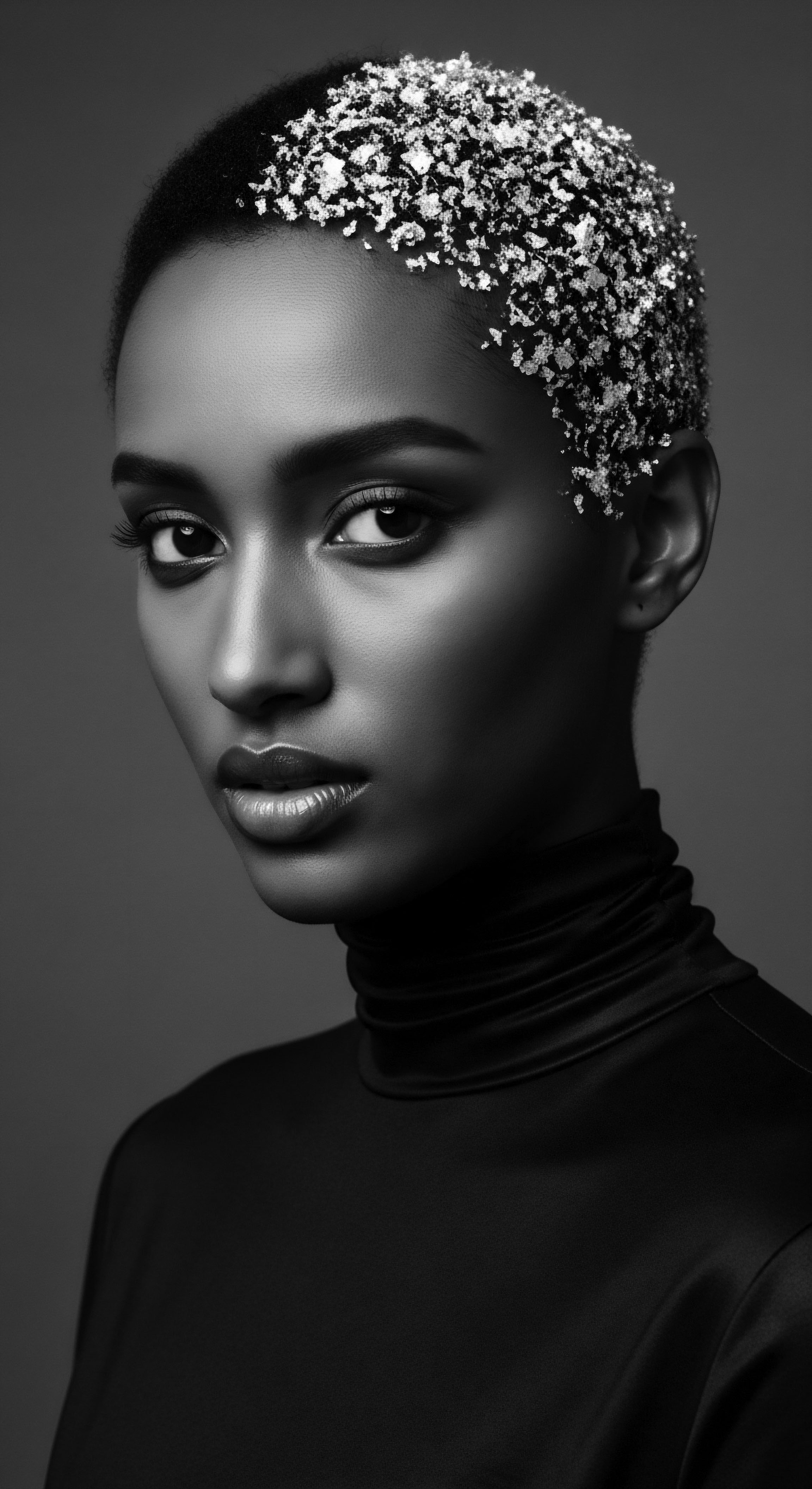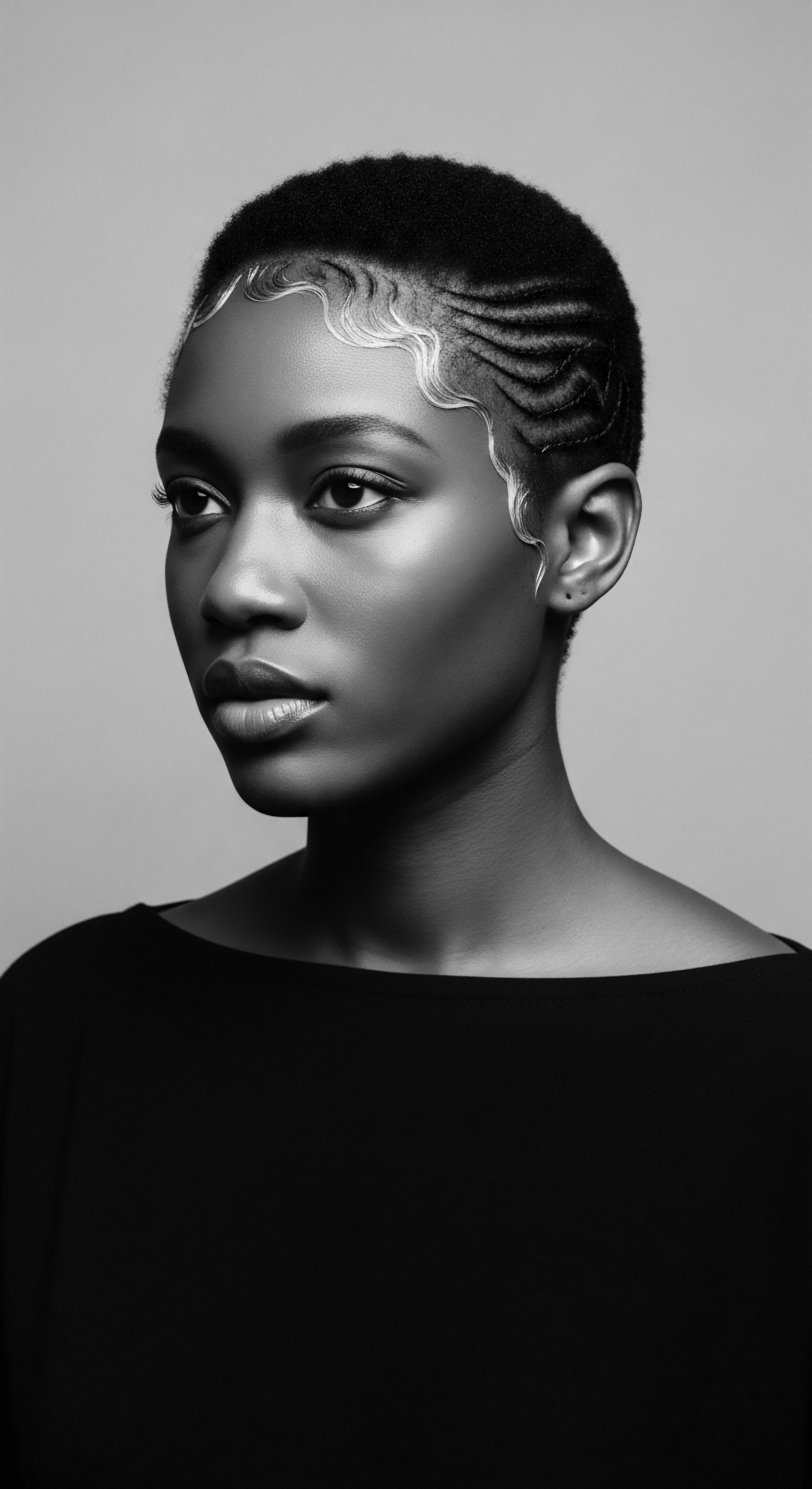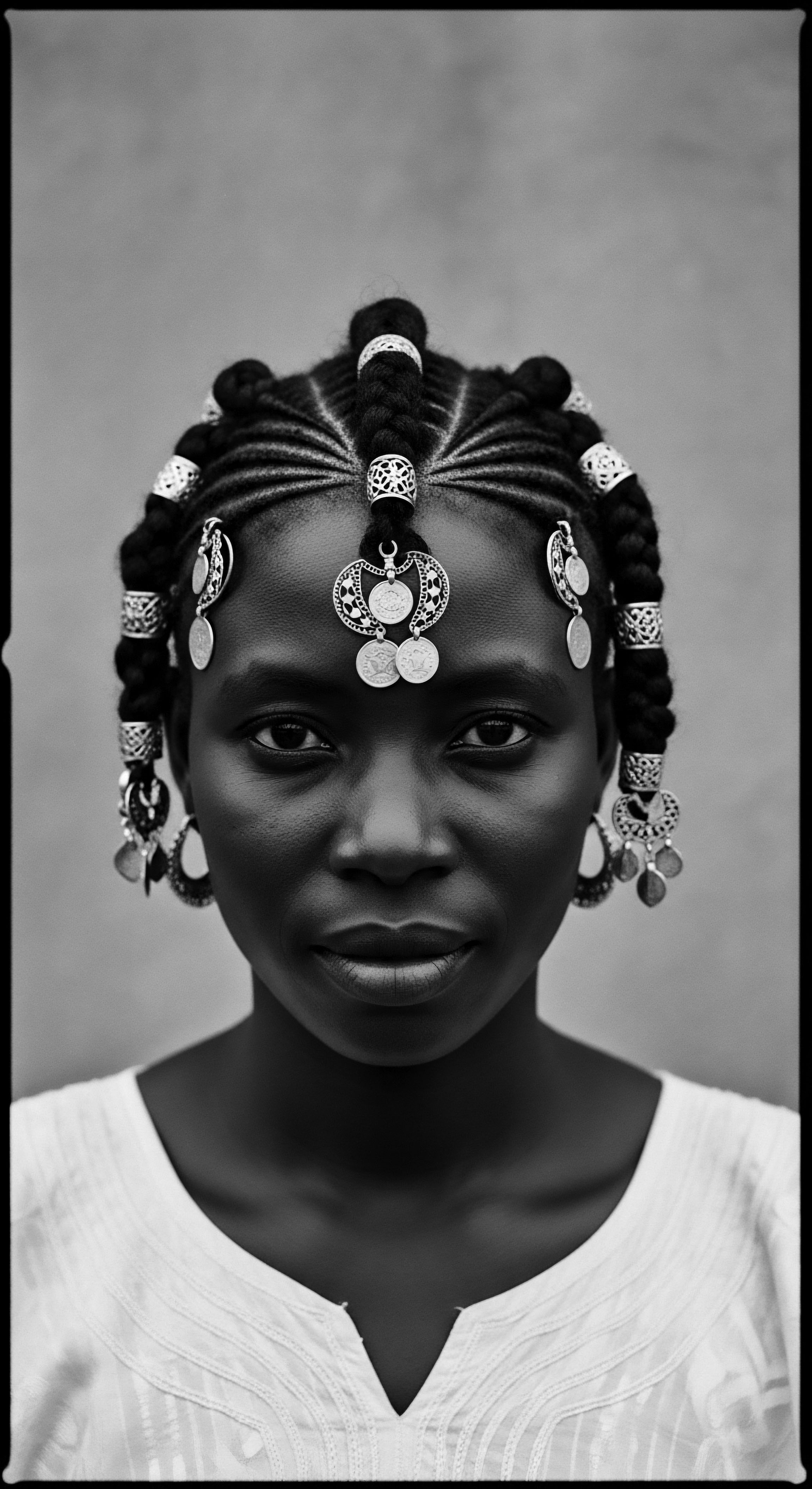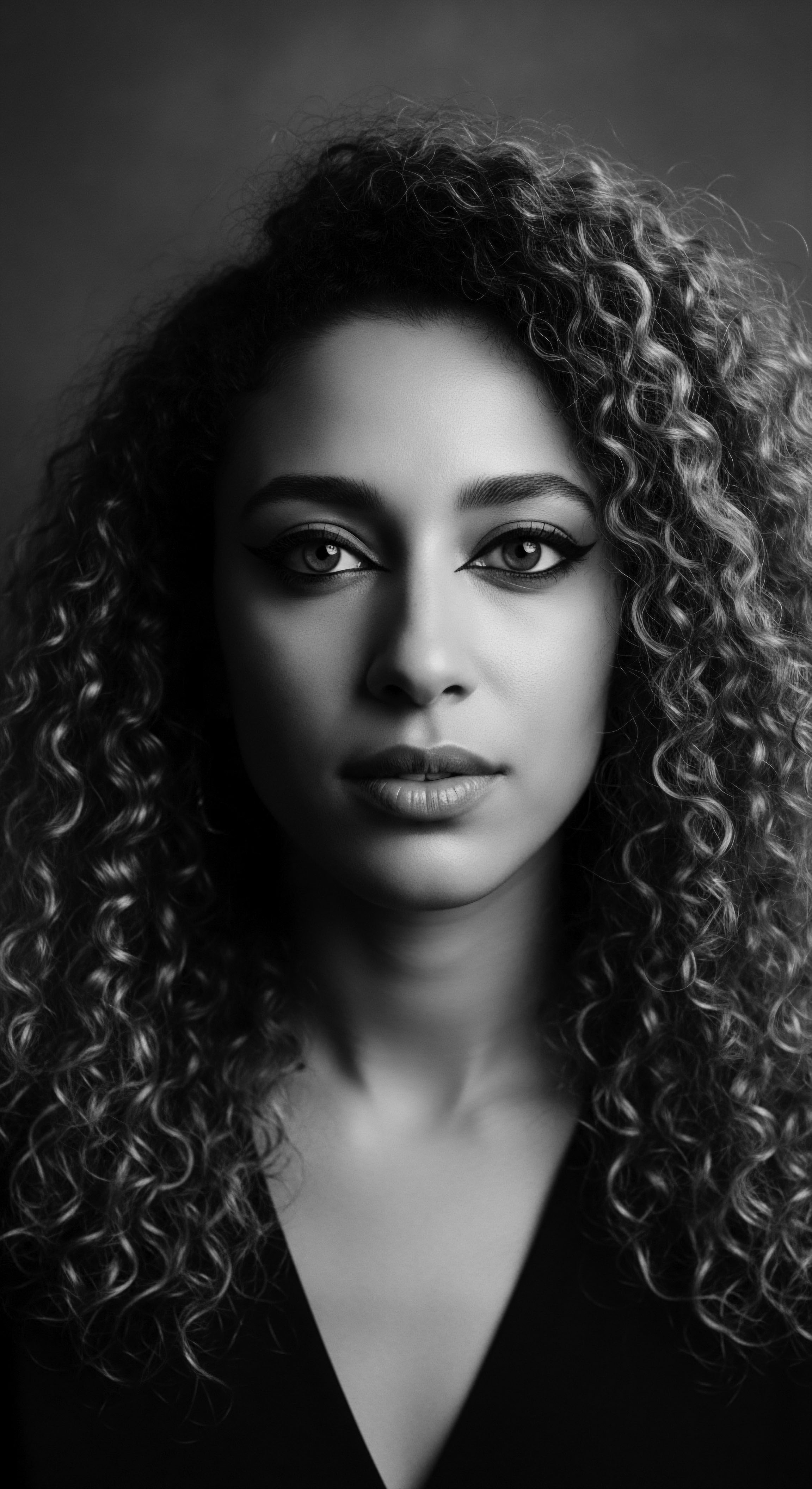
Fundamentals
The concept of Silver Hair Wisdom, within the expansive realm of textured hair, represents far more than a simple biological shift in pigment. It is a profound declaration, a living testament, and an enduring archive of inherited knowledge, experience, and resilience. This wisdom, often seen in the shimmering strands of gray or white, signals a deeper transformation, extending beyond the visible to touch the very core of identity and cultural continuity.
For individuals with textured hair, particularly those from Black and mixed-race lineages, the emergence of silver tones carries a unique resonance. It speaks of a heritage that has navigated centuries of adaptation, innovation, and unwavering spirit.
This understanding, or explication, begins with acknowledging the natural process of depigmentation in hair follicles, where melanin production wanes. What appears as a simple change in hue, however, becomes an invitation to explore the profound meaning embedded within. Silver Hair Wisdom is the recognition that these strands are not merely indicators of age, but rather visible markers of lived narratives, of stories etched into the very fiber of one’s being. It is a statement of time passed, lessons learned, and the quiet authority that accrues with years of navigating the world.
Silver Hair Wisdom unveils itself as a living library, where each silvery strand holds generations of cultural memory and ancestral insight.
Across various cultures with rich textured hair traditions, the veneration of elders and their silvery crowns stands as a foundational principle. This reverence is not simply for their chronological age, but for the profound repository of understanding they represent. Their hair becomes a visual metaphor for the accumulated knowledge passed down through oral traditions, hands-on practices, and the subtle cues of daily existence. It is about an deep understanding of ancestral practices, the nuanced care rituals, and the deep connection to community that their presence signifies.
In many ancestral contexts, the appearance of silver hair was a significant marker. It often heralded a transition into a new stage of life, one defined by increased respect, consultative roles within the community, and the sacred duty of preserving and transmitting cultural practices. The care of silver textured hair, therefore, was itself a ritual, reflecting the high esteem in which these individuals were held. The meaning of these rituals extended beyond mere aesthetics; they were acts of honoring, of acknowledging the individual’s role as a keeper of the collective memory and a bridge to the ancestors.
This designation, Silver Hair Wisdom, also encompasses a practical dimension. It includes the accumulated knowledge of how textured hair responds to various environmental factors, the efficacy of traditional herbs and oils, and the techniques for maintaining hair health through generations. This is a practical knowledge, built from observation and passed down through direct experience, forming a core part of familial and communal heritage. The very act of caring for silver hair often becomes a moment for intergenerational bonding, where knowledge is shared and cultural threads are strengthened.
The statement of Silver Hair Wisdom acknowledges the intrinsic link between the biological reality of hair and its deeply rooted cultural significance. It invites individuals, particularly those with textured hair, to view their silvering strands not as a sign of diminishment, but as an emblem of enduring strength, deep connection, and an unbroken lineage of understanding.

Intermediate
Moving beyond its fundamental recognition, the intermediate interpretation of Silver Hair Wisdom extends into its operational aspects—how this inherited insight actually functions within the vibrant sphere of textured hair heritage. This deepens the clarification of what it means to carry such wisdom, exploring its manifestation in tangible practices and its significance as a form of cultural transmission. The shift to silver in textured hair, whether coils, curls, or waves, often requires a recalibration of care. This is where inherited wisdom truly shines, guiding individuals through changes in texture, porosity, and strength.
This concept involves a sophisticated understanding of hair’s changing biology, yet it is often articulated through the language of traditional wellness. For instance, the understanding that silver hair can feel coarser or drier due to changes in sebum production or cuticle structure is frequently addressed in ancestral practices through the consistent application of specific emollients or hydration techniques. The import of such practices points to generations of empirical observation, often without formal scientific nomenclature, yet yielding demonstrably effective results for hair care.
Silver Hair Wisdom represents an active engagement with the living traditions of hair care, adapting ancestral knowledge to the evolving needs of textured strands.
Consider the profound role of traditional communal hair practices. In many Black and mixed-race communities, hair care has always been a communal activity, a space for storytelling, shared laughter, and the quiet transfer of knowledge. The presence of elders with silver hair in these circles signifies a continuity of expertise.
Their gentle hands, their specific recommendations for detangling or braiding, and their choice of natural ingredients embody this wisdom. This isn’t merely about technique; it encompasses the spirit of patience, the importance of intention, and the spiritual connection to the earth’s bounty for hair’s well-being.
The denotation of Silver Hair Wisdom also includes its role in reinforcing communal identity. In societies where hair has served as a powerful signifier of status, marital status, age, and spiritual connection, the visual presence of silver hair communicates a person’s standing as a respected elder. This respect translates into their opinions being sought, their advice valued, and their presence revered within social structures. The meaning here stretches into the fabric of social cohesion, where the wisdom of the silver-haired contributes to the collective well-being and decision-making of the group.
One can observe this practical application in the meticulous way certain ingredients are historically utilized for aging textured hair. For example, the use of shea butter (Vitellaria paradoxa) or African black soap in West African traditions extends far beyond simple cleansing or moisturizing. These practices, honed over centuries, demonstrate an intuitive understanding of the lipid content, pH balance, and restorative properties that benefit silver hair, which often tends towards dryness and fragility. The knowledge of their precise application, the temperature at which they should be prepared, or their combination with other botanicals, constitutes a segment of this Silver Hair Wisdom.
- Shea Butter ❉ Revered for its rich emollients, historically applied to silvering hair for its profound moisturizing and protective qualities, particularly against environmental stressors.
- Chebe Powder (from Croton Zambesicus) ❉ A Chadian tradition where finely ground herb powder mixed with oils is applied to the hair to promote moisture retention and length, an ancestral practice supporting hair strength as it ages.
- Aloe Vera ❉ Used across various African diasporic traditions for its soothing and hydrating properties, offering gentle care to the often more delicate silver strands and scalp.
The implication here is that Silver Hair Wisdom is not a static concept; it evolves. It is the continuous discernment and application of ancestral techniques to contemporary challenges, making traditional knowledge vibrant and relevant for today’s textured hair journeys. The significance lies in its adaptable nature, demonstrating how practices rooted in antiquity can continue to offer profound guidance for the health and vitality of silver textured hair in the modern era.

Academic
At an academic stratum, Silver Hair Wisdom constitutes a complex, interdisciplinary construct, a profound examination of the accumulated epistemological, somatic, and socio-cultural capital embodied within the visible transformation of hair pigmentation, particularly within populations with textured hair heritages. This advanced delineation posits that the shift from pigmented to anachromic strands in individuals of Black and mixed-race descent is not merely a biological phenomenon. Instead, it serves as a potent semiotic marker, signifying an individual’s accrued life experience, their pivotal role as a repository of communal memory, and the enduring resilience of ancestral practices.
The meaning of Silver Hair Wisdom, viewed through an academic lens, encompasses the intricate interplay between biological aging, ethnobotanical applications, and the socio-historical construction of beauty and authority. It is a nuanced explication of how the physical manifestation of silver hair becomes intertwined with deeply embedded cultural values, often elevating the individual to a status of revered elder. This designation implies a transfer of knowledge that transcends formal education, rooted instead in years of direct observation, intergenerational dialogue, and an intuitive understanding of the natural world, particularly as it pertains to the human body and its adornments.
Silver Hair Wisdom, academically examined, reveals a complex intersection of biological aging, cultural reverence, and epistemological transfer within textured hair communities.
Consider the profound societal reverence for elders in many traditional African societies. In the Yoruba tradition of Southwest Nigeria, for instance, the term Agba refers to an elder, a person of advanced age, whose gray or white hair (Ewú) is a direct symbol of their immense knowledge, experience, and proximity to the ancestors. Drewal and Drewal (1983) meticulously document how the visual presence of ewú confers authority and wisdom, indicating a person who has seen many seasons, mastered many challenges, and thus possesses the sagacity to guide the community. This isn’t a passive respect; it is an active engagement where elders, characterized by their silver hair, are sought for counsel, arbitration, and the transmission of crucial cultural narratives and spiritual insights.
The very act of touching an elder’s silver hair or receiving their blessing is deeply significant, symbolizing the transfer of wisdom and good fortune. This reverence for ewú directly counters Western-centric notions that often equate graying hair with decline or a loss of vibrancy, instead highlighting an ascension to a higher socio-spiritual plane.
The significance of this phenomenon extends into the realm of hair care practices themselves. The transition to silver hair often brings about changes in strand diameter, cuticle integrity, and moisture retention. Traditional care modalities, developed long before modern cosmetology, inherently understood these shifts.
The historical deployment of specific botanical ingredients and methods, such as extensive oiling, gentle manipulation, and protective styling for maturing textured hair, serves as a powerful demonstration of this ancestral scientific inquiry. These are not random acts, but precise applications derived from empirical observation passed down through generations.
| Traditional Practice/Ingredient Plant-based Oils (e.g. coconut, olive, argan) |
| Historical Application/Benefit Regularly massaged into scalp and strands for lubrication and sheen, protecting against dryness and breakage, particularly in coarser silver textures. |
| Contemporary Scientific Correlation Rich in fatty acids (e.g. lauric, oleic), these oils provide occlusion, reduce protein loss, and replenish the lipid barrier of the hair shaft, which is often compromised in silver hair. |
| Traditional Practice/Ingredient Protective Styling (e.g. braids, twists, wraps) |
| Historical Application/Benefit Used to minimize daily manipulation, reduce environmental exposure, and prevent tangling, preserving the integrity of fragile silver strands. |
| Contemporary Scientific Correlation Minimizes mechanical stress, preserves moisture, and protects the cuticle layer from external damage, crucial for maintaining tensile strength in often more delicate silver hair. |
| Traditional Practice/Ingredient Herbal Rinses/Infusions (e.g. rosemary, hibiscus) |
| Historical Application/Benefit Applied to cleanse the scalp, balance pH, and impart shine or tint, sometimes used to soften textured silver hair. |
| Contemporary Scientific Correlation Contain antioxidants, anti-inflammatory compounds, and mild acids that can clarify the scalp, improve circulation, and condition the hair cuticle, contributing to hair health and appearance. |
| Traditional Practice/Ingredient These practices underscore a deep, ancestral understanding of hair biology and its preservation across the lifespan, particularly for silvering textured strands. |
The sustained use of these methodologies, despite limited access to modern scientific tools, points to an advanced, embodied form of knowledge production. This continuous empirical validation across communities, documented ethnographically, reinforces the rigorousness of what we term Silver Hair Wisdom. It is a comprehensive system of knowledge that addresses the physiological changes of aging hair alongside its profound cultural and spiritual dimensions.

Socio-Political Dimensions of Silver Hair Wisdom
Beyond its traditional valorization, the explication of Silver Hair Wisdom must also consider its socio-political implications, particularly within post-colonial and diasporic contexts. In environments where Eurocentric beauty standards have historically marginalized textured hair, the choice to wear silver hair naturally and with pride becomes an act of quiet resistance and self-affirmation. This becomes a conscious decision to reject imposed norms of youth and chemically altered aesthetics, re-centering an ancestral understanding of beauty that honors the entire life cycle.
The emergence of this wisdom as a contemporary movement, particularly among Black and mixed-race individuals, is a powerful reclaiming. It is a declaration of self-acceptance, a celebration of authenticity, and a visible connection to a lineage of resilience. This phenomenon highlights how inherited cultural values, once suppressed, are now being revitalized as powerful tools for identity formation and community building. The choice to embrace silver hair is often accompanied by a renewed interest in traditional hair care practices, creating a cyclical reinforcement of ancestral knowledge.
- Reclamation of Identity ❉ Embracing silver hair often signifies a rejection of Eurocentric beauty standards and a deliberate return to ancestral aesthetics, affirming a deep connection to heritage.
- Intergenerational Dialogue ❉ The visible presence of silver hair fosters conversations about family history, traditional practices, and lived experiences, strengthening communal bonds.
- Symbol of Resilience ❉ For many, silver hair represents survival and strength through life’s challenges, embodying a legacy of fortitude inherited from past generations.
- Environmental Consciousness ❉ A preference for natural hair, including silver, often aligns with a broader movement towards sustainable and culturally informed hair care products, honoring ancestral respect for nature.
The implication here is that Silver Hair Wisdom is a dynamic, living concept. It continues to shape individual and collective experiences, offering a profound sense of continuity and empowerment. It is a statement that hair, particularly textured hair, serves as a powerful conduit for ancestral memory, ongoing resistance, and the enduring celebration of cultural identity. The designation of this phenomenon as “wisdom” underscores its deep, multifaceted value—a value derived not just from years, but from the cumulative intelligence of generations.

Reflection on the Heritage of Silver Hair Wisdom
The journey through Silver Hair Wisdom reveals a profound truth ❉ hair is far more than mere biological filament. For those who trace their lineage through textured strands, it is a living chronicle, a soulful repository of memory, triumph, and ancestral connection. The emergence of silver within these coils and waves speaks not of conclusion, but of a sacred unfolding, a visible manifestation of time’s gentle hand intertwining with the enduring spirit of heritage. This understanding encourages a perspective where each silvery thread becomes a whisper from generations past, offering guidance and affirmation.
In reflecting on this wisdom, we acknowledge the profound gift passed down through the ages ❉ the deep, intuitive knowledge of how to care for and honor textured hair through all its transitions. This inherited knowledge, often preserved in the simplest of rituals—a gentle comb-out, a carefully chosen oil, a shared moment of braiding—forms the very bedrock of Silver Hair Wisdom. It reminds us that our hair is a continuous conversation with our ancestors, a dialogue of care, identity, and unwavering reverence for the path they cleared.
The future of Silver Hair Wisdom, particularly within Black and mixed-race communities, appears vibrant and assured. As more individuals choose to reveal their natural silver crowns, they are not only making a personal statement but also participating in a collective affirmation of heritage. This act fortifies the legacy, making visible the profound understanding that has always resided within these communities.
It is a beautiful continuity, demonstrating how the past, with its rich tapestry of practices and beliefs, informs and enriches the present. The Soul of a Strand, truly, is eternal, shimmering with the timeless Silver Hair Wisdom.

References
- Drewal, Henry John, and Margaret Thompson Drewal. Gelede ❉ Art and Female Power Among the Yoruba. Indiana University Press, 1983.
- Mercer, Kobena. “Black Hair/Style Politics.” New Formations, no. 10, 1990, pp. 33-52.
- Byrd, Ayana, and Lori L. Tharps. Hair Story ❉ Untangling the Roots of Black Hair in America. St. Martin’s Press, 2001.
- Okoro, Nkemdilim. Culture and Cosmetics ❉ A Study of the Social History of Hair in Nigeria. University of Ibadan Press, 2010.
- Opoku, Kwasi. West African Traditional Religion. FEP International Private Limited, 1978.
- Patel, Nikisha. The World of Natural Hair ❉ A Guide to Natural Hair Care for African Women. Self-published, 2018.
- Weems, Robert E. Jr. Building the Black Metropolis ❉ African Americans in Chicago and the Great Migration. University of Illinois Press, 1998.
- Hooks, bell. Bone Black ❉ Memories of Girlhood. Henry Holt and Company, 1996.
